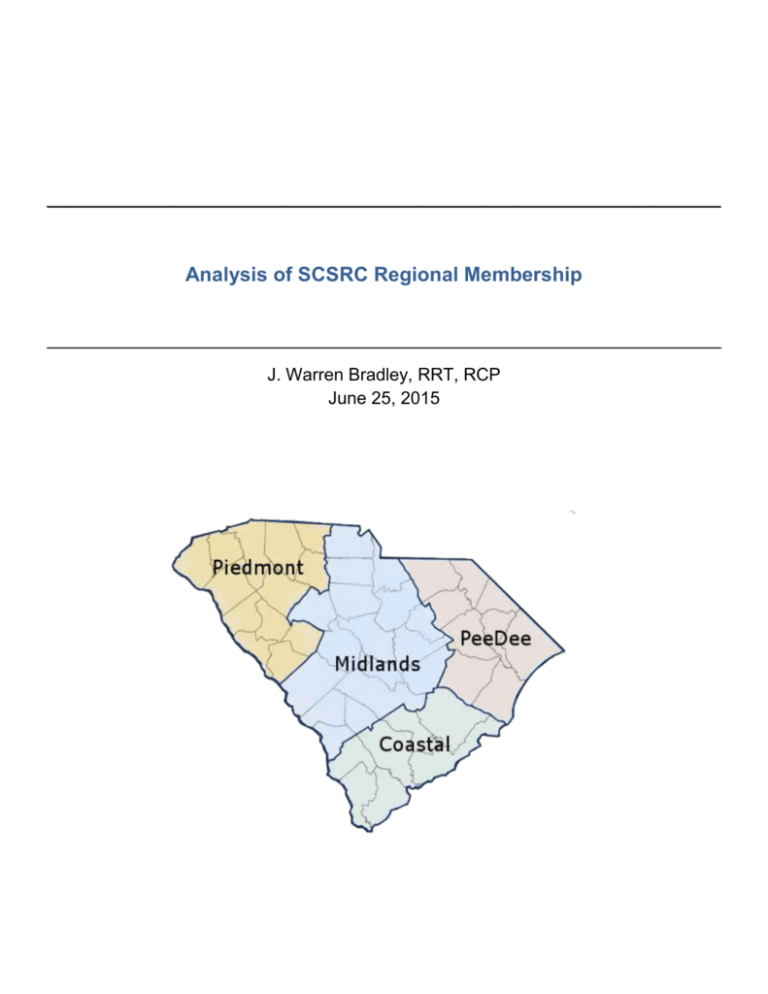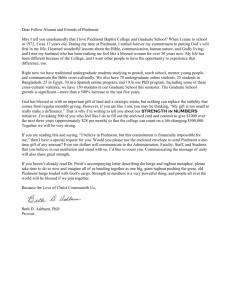
_____________________________________________________________________
Analysis of SCSRC Regional Membership
_____________________________________________________________________
J. Warren Bradley, RRT, RCP
June 25, 2015
Introduction
It has been said that not everything that can be counted counts, and not everything that counts can be
counted.0 I sat down at my computer months ago in order to answer a simple question regarding which
SCSRC region has the highest membership rate. It seemed to be a fairly simple inquiry at the time…
Executive Summary
AARC/SCSRC membership data was aggregated with data for SC Counties, Cities, and SCSRC Regions and
the results extrapolated using Microsoft Excel. Data analysis revealed that the Piedmont Region has the
highest number of SCSRC members at (306/798 -38.11%). As expected, membership distribution was highest
in larger cities such as Charleston, Greenville, and Columbia.
Subsequent analysis of South Carolina population data (US Census Bureau 2010) by county (region)
demonstrated significant population inequality between SCSRC Regions. In order to statistically compensate
for disparate populations a rate calculation (County SCSRC Members x 10,000) / County Population) was
utilized to determine population adjusted membership. This analysis revealed that Greenwood County has the
highest population adjusted membership at (4.2) SCSRC Members / 10K population. Interestingly, Abbeville
County (pop 25,000) was also distinguished at (3.6) in a tie with Charleston County (pop 350,209) despite the
fact the former only has a fraction of the population of the latter. Since there is a relatively linear relationship
between population and regional HCO density, population adjusted SCSRC membership data provides a good
way to compare involvement across areas of disparate population. In fact, hospital bed data indicates that the
Midlands and Piedmont regions lead in both population and hospital beds. Mean SCSRC population adjusted
membership per 10,000 population was highest in the Piedmont Region at (1.92), the Coastal followed with
(1.8), Midlands at (1.17), and PeeDee at (1.12).
After demonstrating a significant population inequality, a hypothetical regarding the possible benefit of
realigning SCSRC Regions to be more population equivalent, and a method for accomplishing this goal is
offered for evaluation.
Analysis of South Carolina State Budget and Control Board data of South Carolina Licensed Respiratory Care
Practitioners (RCP’s) was undertaken and as expected, the Piedmont Region who had the highest number of
SCSRC Members also has the largest number of licensed practitioners (928, 32.04%). Even when the data is
population adjusted, the Piedmont remains on top with (6.5) RCP’s / 10K Population.. Surprisingly, 389 of the
(2896) total SC RCP’s (13.43%) were from other states.
When the ratio of regional SCSRC members to RCP’s was evaluated, the Coastal Region had the highest rank
with (45.24%) of the available licensed practitioners represented as SCSRC members. This is followed by the
Piedmont at (32.97%), the Midlands at (27.88%) and the PeeDee at (19.62%). The ratio for all regions
(803/2896) was (27.73%). RCP’s from other states only accounted for (1.29%) of SCSRC members.
(I)
Analysis of SCSRC Regional Membership
_____________________________________________________________________
Regions: The SCSRC is currently divided into 4 geopolitical regions:
Piedmont
Midlands
Coastal
PeeDee
Initial Methods
In order to determine the percentage of current SCSRC members from each region, May 2015 AARC
membership data was compiled using Microsoft Excel and population data for each SC County1, data
regarding SC cities by county2, and SCSRC regions by county.3
Results
Region
Piedmont
Coastal
Midlands
PeeDee
Other States
Subtotal
SCSRC
Members
306
214
206
72
5
798
% Total
38.11
26.65
25.65
8.97
0.62
99.38
Out of State
NC
GA
WV
Subtotal
3
1
1
5
0.37
0.12
0.12
0.62
803
100
Total
Ranking
1
2
3
4
5
Percentage of SCSRC Membership by Region4
Piedmont
0.62
8.97
Coastal
38.11
25.65
Midlands
PeeDee
26.65
Other States
(1)
Data Analysis
Casual analysis demonstrates that the Piedmont region has a significantly larger number of SCSRC members
than any other SCSRC region. Although Coastal and Midlands regions are almost identical, the PeeDee
seems to be drastically underrepresented. Surprisingly, we also have five members with out of state
addresses.
But this is based on raw data and is not population adjusted. Once we adjust for population the picture
becomes slightly more nebulous.
SC Population
The Census data below5 and population heat map13, A3 indicate a lack of homogeneity in population across the
arbitrary SCSRC regions.
Membership Rate Calculation
In order to obtain more accurate statistics, it is necessary to perform a Rate calculation6 for membership using
the formula (County SCSRC Members x 10,000) / County Population). This provides population adjusted
SCSRC practitioners per 10,000 of SC population. This data along with similar percent of SCSRC, and % SC
population by County data follows.
(2)
SCSRC
Per 10K
Pop
Members
% SCSRC
Population
% SC
Population
Greenwood
29
3.61
69,661
1.506
4.2
Abbeville
Charleston
Newberry
Dorchester
Spartanburg
Marion
Greenville
Pickens
Lexington
Calhoun
McCormick
Colleton
Orangeburg
Jasper
Dillon
Saluda
Florence
Union
Barnwell
Aiken
Berkeley
Richland
Oconee
Laurens
Georgetown
Chesterfield
Anderson
York
Allendale
Cherokee
Clarendon
Fairfield
Sumter
Horry
Darlington
Marlboro
Kershaw
Bamberg
Beaufort
Chester
Lancaster
Hampton
Edgefield
Williamsburg
Lee
NC
GA
WV
All
9
125
13
44
82
8
109
25
54
3
2
7
16
4
5
3
19
4
3
21
23
47
9
8
7
5
20
24
1
5
3
2
8
20
5
2
4
1
10
2
4
1
1
1
0
3
1
1
803
1.12
15.57
1.62
5.48
10.21
1.00
13.57
3.11
6.72
0.37
0.25
0.87
1.99
0.50
0.62
0.37
2.37
0.50
0.37
2.62
2.86
5.85
1.12
1.00
0.87
0.62
2.49
2.99
0.12
0.62
0.37
0.25
1.00
2.49
0.62
0.25
0.50
0.12
1.25
0.25
0.50
0.12
0.12
0.12
0.00
0.37
0.12
0.12
100.00
25,000
350,209
37,508
136,555
284,307
33,062
451,225
119,224
262,391
15,175
10,233
38,892
92,501
24,777
32,062
19,875
136,885
28,961
22,621
160,099
177,843
384,504
74,273
66,537
60,158
46,734
187,126
226,073
10,419
55,342
34,971
23,956
107,456
269,291
68,681
28,933
61,697
15,987
162,233
33,140
76,652
21,090
26,985
34,423
19,220
0.541
7.572
0.811
2.953
6.147
0.715
9.756
2.578
5.673
0.328
0.221
0.841
2.000
0.536
0.693
0.430
2.960
0.626
0.489
3.462
3.845
8.314
1.606
1.439
1.301
1.010
4.046
4.888
0.225
1.197
0.756
0.518
2.323
5.823
1.485
0.626
1.334
0.346
3.508
0.717
1.657
0.456
0.583
0.744
0.416
3.6
3.6
3.5
3.2
2.9
2.4
2.4
2.1
2.1
2.0
2.0
1.8
1.7
1.6
1.6
1.5
1.4
1.4
1.3
1.3
1.3
1.2
1.2
1.2
1.2
1.1
1.1
1.1
1.0
0.9
0.9
0.8
0.7
0.7
0.7
0.7
0.6
0.6
0.6
0.6
0.5
0.5
0.4
0.3
0.0
4,624,947
100.00
County
(3)
Results
When viewed with population adjusted data (shown below), Abbeville County, with only nine practitioners can
hold up their head alongside Charleston with 125, since the two areas are proportionally identical with (3.6
practitioners /10,000 population) in population adjusted SCSRC membership. And of course Greenwood rules!
4.5
4.0
3.5
3.0
2.5
2.0
1.5
1.0
0.5
Greenwood
Abbeville
Charleston
Newberry
Dorchester
Spartanburg
Marion
Greenville
Pickens
Lexington
Calhoun
McCormick
Colleton
Orangeburg
Jasper
Dillon
Saluda
Florence
Union
Barnwell
Aiken
Berkeley
Richland
Oconee
Laurens
Georgetown
Chesterfield
Anderson
York
Allendale
Cherokee
Clarendon
Fairfield
Sumter
Horry
Darlington
Marlboro
Kershaw
Bamberg
Beaufort
Chester
Lancaster
Hampton
Edgefield
Williamsburg
Lee
0.0
Usefulness
Assuming a relatively linear relationship between population and regional HCO density, population adjusted
SCSRC membership data provides a good way to compare involvement across areas of disparate
population.7,A4
(4)
Data by City – Members
Data granularity allows discrimination all the way down to the individual city (shown) or even HCO.
York
Rock Hill
Sumter
Blythewood
Laurens
Chapin
Piedmont
Beaufort
Abbeville
Fort Mill
Orangeburg
Mt Pleasant
Johns Island
Newberry
Boiling Springs
Myrtle Beach
Taylors
Anderson
Ladson
North Charleston
Goose Creek
Florence
North Augusta
Inman
West Columbia
Mount Pleasant
Easley
Greer
Greenwood
Lexington
Simpsonville
Spartanburg
Summerville
Columbia
Greenville
Charleston
0
10
20
30
(5)
40
50
60
Regional Population Analysis
If we assume that the SCSRC Regions were initially assigned administratively in order to equally divide the
state into management units based on the number of practitioners in each area, unequal growth has lead to
significant inequality.
Population Inequality by Current SCSRC Region
Coastal
Beaufort
Berkeley
Charleston
Colleton
Dorchester
Hampton
Jasper
19.710%
162,233
177,843
350,209
38,892
136,555
7
21,090
24,777
911,599
PeeDee
15.356%
Chesterfield
46,734
Darlington
68,681
Dillon
32,062
Florence
136,885
Georgetown
60,158
Horry
269,291
Marion
33,062
Marlboro
28,933
Williamsburg 34,423
9
Midlands
Aiken
Allendale
Bamberg
Barnwell
Calhoun
Chester
Clarendon
Fairfield
Kershaw
Lancaster
Lee
Lexington
Newberry
Orangeburg
Richland
Sumter
York
34.257%
17
1,584,370
710,229
160,099
10,419
15,987
22,621
15,175
33,140
34,971
23,956
61,697
76,652
19,220
262,391
37,508
Piedmont
Abbeville
Anderson
Cherokee
Edgfield
Greenville
Greenwood
Laurens
McCormick
Oconee
Pickens
Saluda
Spartanburg
Union
30.676%
13
1,418,749
25,000
187,126
55,342
26,985
451,225
69,661
66,537
10,233
74,273
119,224
19,875
284,307
28,961
92,501
384,504
107,456
226,073
3 Region Target
4,624,947
1,156,237
1,541,649
Merge Coastal & PeeDee
1,621,828
Total
4 Region Target
20%
Coastal
31%
PeeDee
15%
Midlands
Piedmont
34%
(6)
Suggested Modification of Regions to Attain Regional Parity
Reassign Chesterfield and Marlboro Counties from the PeeDee to the Midlands Region.
Merge the Coastal and remaining PeeDee region counties into a new Lowcountry Region.
Reassign Newberry, Fairfield, and Chester Counties from the Midlands Region to the Piedmont Region
and rename the Piedmont Region to the Upstate Region.
Resultant Regional Population Distribution
Region
Lowcountry
Midlands
Upstate
Population
%
1,546,161 33.43%
1,565,433 33.85%
1,513,353 32.72%
4,624,947
Upstate
Midlands
Lowcountry
(7)
Nomenclature, Geography, Convention, and Organizational Taxonomy
There are numerous ways to define regions and our current method seems to borrow from geographic (see
below), political, and organizational conventions. Obviously our Piedmont region includes the mountainous
counties of the Blue Ridge, and the Midlands stand in for our Coastal Plain. But the PeeDee and Coastal
regions seem to be borrowed from the SC Forest Service. In any case, simplification using the suggested new
Upstate, Midlands, Lowcountry schema is vastly superior. This model is based on realignment of contiguous
counties into the new regions – so as to gerrymander 3 regions with essentially equivalent population.
Accordingly, this population equivalence is held to be directly proportional to the density of healthcare
organizations in those regions, and hence the equivalent need for RCP’s in each new region7. This is directly
validated by the actual distribution of hospital beds8, A3.
A Pragmatic Alternative to Change
If you ever fish for trout9, you can learn to predict where trout will lie based on the hydraulics of the stream. The
trout wants to exert minimum effort to obtain a maximum food reward. He finds a current pocket with
decreased flow, located behind an obstruction that is just adjacent to a high flow confluence. This is known as
a current seam, where several currents combine into one and anything floating (such as a tasty insect) is
naturally concentrated. The trout looks up all day, casually swimming against the weak current, until he sees a
potential meal worth the effort of exerting himself – and then darts out to retrieve it with a casual sip. Although I
dearly love methodical reorganization, it sometime pays to think like a trout.
Since remapping and renaming of SCSRC regions requires Board of Directors (BOD) approval and
subsequent American Association for Respiratory Care (AARC) House of Delegates (HOD) approval, it may
well represent a diminishing return on the investment to accomplish the proposed outcome. It is necessary
from a pragmatic perspective to ask what benefit could ONLY be attained by remapping regions. The answer is
that there is very little that could not also be accomplished by the use of statistical analysis in evaluating the
performance of regions. To this end, I offer both the quiet trout and my original ‘reptile brain’ alternatives for
evaluation.
(8)
RCP’s, Population, and Licensure Rate by SCSRC Region5, 10
Region
RCP’s
% Total
Population
Rate / 10K
5.2
5.2
4.7
6.5
Coastal
PeeDee
Midlands
Piedmont
Other
473
367
739
928
389
16.33
12.67
25.52
32.04
13.43
911,599
710,229
1,584,370
1,418,749
Total
2896
100.00
4,624,947
13%
16%
Coastal
PeeDee
13%
32%
Midlands
Piedmont
Other
26%
Source: South Carolina Budget and Control Board RCP Data (6/2015), 2010 US Census
Comparison with SCSRC Population Data
20%
Coastal
31%
PeeDee
15%
Midlands
Piedmont
34%
(9)
Ratio of SCSRC Members to RCP’s by Region
In the same way that we used a rate calculation to show population adjusted statistics by county and region,
we can use the ratio of SCSRC members to RCP’s to provide an assessment of population adjusted SCSRC
participation. This yields some surprising results – when, for example, the Coastal region with a significantly
lower number of members actually has a higher percentage of members from the available pool of licensed
respiratory care practitioners.
Composite Data Analysis
Region
Piedmont
Coastal
Midlands
PeeDee
Other States
Total
Members
306
214
206
72
5
%
Total Ranking
38.11
1
26.65
2
25.65
3
8.97
4
0.62
5
RCP’s
928
473
739
367
389
803
%
Total
32.04
16.33
25.52
12.67
13.43
Rank
1
3
2
5
4
2896
RCP
Ratio
32.97
45.24
27.88
19.62
1.29
Rank
2
1
3
4
5
27.73
Graphic Regional Ranking by Population, SCSRC Membership, Licensure, RCP Ratio, and Hospital
Beds
Population
Midlands
Piedmont
Coastal
PeeDee
N/A
Membership
Piedmont
Coastal
Midlands
PeeDee
Other States
RCP’s
Piedmont
Midlands
Coastal
Other States
PeeDee
RCP Ratio
Coastal
Piedmont
Midlands
PeeDee
Other States
Hospital Beds
Midlands
Piedmont
PeeDee
Coastal
N/A
Overall Results
This study has yielded information that can provide actionable intelligence for policy makers. The
methodologies used can form the basis of a periodic monitoring program to facilitate future administrative
action. For example, a regional membership improvement program might be based on competition between
regions judged by percentage change in RCP Ratio.
For the purposes of allocating membership drive and other society resources, regions should be prioritized in
reverse order of RCP Ratio. In this schema, the PeeDee region would receive the most effort, followed by the
Midlands and then Piedmont and Coastal regions. Additional efforts should be made to identify causal factors
resulting in the high proportion of licensed therapists from the Coastal region who participate in the SCSRC.
If all regions increased recruiting to a 45%+ RCP Ratio (Like the Coastal Region), it would represent an
increase of 915 new members – more than doubling of SCSRC membership. (1,718 projected members – 803
current members) / 803 current members = (915/803)* 100 = 113.9% projected increase11 at a 45% RCP Ratio
for all regions.
(10)
Conclusion
Analytics12 can be invaluable in assigning SCSRC resources for the purpose of membership drives,
educational activities, and in focusing BOD administrative activity. The data necessary is readily available and
easy to extrapolate with simple Excel spreadsheet functionality. If the AARC would work to develop a national
membership dashboard, all state societies would be able to focus their membership efforts more effectively
and understand precisely how their performance compares to that of other state affiliates. The House of
Delegates Resolution on this issue that I will be submitting follows the appendix of this report.
Recommendations
To optimize the administrative efficiency of the SCSRC, we must leverage analytics by monitoring vital metrics
such as membership by region. If we can identify which regions, counties, or HCO’s represent opportunities for
improvement we can focus our resources in those areas. We can utilize simple information technology
solutions to solve complex problems. My recommendations include:
o
o
o
o
o
o
o
o
o
Review this report and decide if further action for realignment of SCSRC Regions is warranted.
Review the AARC National Membership Dashboard ResolutionA7 and decide if submission is
warranted.
Review the data provided and determine if annual analysis would be beneficial.
Recognize the Coastal Region for their high performance in recruiting more than 45% of licensed
practitioners in the region to join the AARC/SCSRC.p 10
Recognize the practitioners of Greenwood, Abbeville, and Charleston counties for their high
performance in population adjusted membership rate.A5.
Recognize the Piedmont Region for having the highest average population adjusted membership rateA6
Recognize the practitioners of Charleston as the city with the highest average population adjusted
membership ratep5
Allocate resources to focus intensive recruitment efforts in the PeeDee Region.p10
Consider a competition among regions based on year over year improvement in any population
adjusted metric or Member : RCP Ratio.
.
Future Reports
My next report, titled The Effect of Regional BBQ Styles on SCSRC Membership14 will be available soon.
(11)
References
0) http://paleofuture.gizmodo.com/9-albert-einstein-quotes-that-are-totally-fake-1543806477 Often attributed to
Albert Einstein but, Einstein never said this. Its origin points to a 1963 paper by sociologist William Bruce Cameron:
"It would be nice if all of the data which sociologists require could be enumerated because then we could run them
through IBM machines and draw charts as the economists do. However, not everything that can be counted counts,
and not everything that counts can be counted."
1) http://en.wikipedia.org/wiki/List_of_counties_in_South_Carolina
2) http://www.state.sc.us/dmh/cities_towns.htm
3) http://www.scsrc.org/regions/
4) May 2015 AARC Membership Data
5) US Census Bureau, 2010 Census Redistricting Data
6) http://www.stats.indiana.edu/vitals/CalculatingARate.pdf
7) https://www.ahd.com/states/hospital_SC.html
8) (http://www.scdhec.gov/Agency/docs/health-regs/61-15.pdf
9) http://www.gameandfishmag.com/fishing/fishing_trout-fishing_sc_aa044804a/
10) South Carolina Budget and Control Board RCP Data (6/2015)
11) http://www.wikihow.com/Calculate-Growth-Rate
12) https://en.wikipedia.org/wiki/Analytics
13) https://commons.wikimedia.org/wiki/File:South_Carolina_population_map.png
14) https://goo.gl/qVWgPr
15) http://goo.gl/uGlmyO
Data, Information, Knowledge, Understanding, and Wisdom
With special thanks to the members of the 2015 SCSRC Information Technology Committee and the members of the Board of Directors for their
support. This special report is dedicated to the Respiratory Care Practitioners of South Carolina, our patients, our coworkers, and the healthcare
organizations we serve. Copyright © 2015, J. Warren Bradley, SCSRC, All rights reserved
(12)
Appendix 1
________________________________________________________________________________________
Population Heat Map
https://commons.wikimedia.org/wiki/File:South_Carolina_population_map.png
A1
Appendix 2
________________________________________________________________________________________
SC Licensed Practitioners from Other States
State
RCP's
AL
AZ
CA
CO
CT
DE
FL
GA
HI
IA
IL
KY
LA
MA
MD
ME
MI
MO
MT
NC
ND
NE
NJ
3
1
6
2
2
2
5
128
1
1
3
5
1
1
2
2
3
1
1
159
2
1
4
NY
2
OH
5
PA
7
PR
1
SD
2
TN
13
TX
3
UT
1
VA
15
WV
3
388
A2
Appendix 3
________________________________________________________________________________________
Distribution of SC Licensed Practitioners from Other States
State
RCP's
GA
NC
TN
VA
All Others
128
159
13
15
73
SC Licensed Out of State RCP's
19%
33%
GA
NC
4%
TN
3%
VA
All Others
41%
A3
Appendix 4
________________________________________________________________________________________
Hospital Beds by SCSRC Region
Region
Beds
Coastal
PeeDee
Midlands
Piedmont
2,533
2,637
3,998
3,347
12,515
% SC Beds
20.24
21.07
31.95
26.74
100.00
Data, American Hospital Directory: https://www.ahd.com/states/hospital_SC.html
20%
27%
Coastal
PeeDee
Midlands
21%
32%
A4
Piedmont
Appendix 5
Population Adjusted SCSRC Membership by County and Region
County
Abbeville
Aiken
Allendale
Anderson
Bamberg
Barnwell
Beaufort
Berkeley
Calhoun
Charleston
Cherokee
Chester
Chesterfield
Clarendon
Colleton
Darlington
Dillon
Dorchester
Edgefield
Fairfield
Florence
Georgetown
Greenville
Greenwood
Hampton
Horry
Jasper
Kershaw
Lancaster
Laurens
Lee
Lexington
Marion
Marlboro
McCormick
Newberry
Oconee
Orangeburg
Pickens
Richland
Saluda
Spartanburg
Sumter
Union
Williamsburg
York
All
Region
Piedmont
Midlands
Midlands
Piedmont
Midlands
Midlands
Coastal
Coastal
Midlands
Coastal
Piedmont
Midlands
PeeDee
Midlands
Coastal
PeeDee
PeeDee
Coastal
Piedmont
Midlands
PeeDee
PeeDee
Piedmont
Piedmont
Coastal
PeeDee
Coastal
Midlands
Midlands
Piedmont
Midlands
Midlands
PeeDee
PeeDee
Piedmont
Midlands
Piedmont
Midlands
Piedmont
Midlands
Piedmont
Piedmont
Midlands
Piedmont
PeeDee
Midlands
Members
9
21
1
20
1
3
10
23
3
125
5
2
5
3
7
5
5
44
1
2
19
7
109
29
1
20
4
4
4
8
0
54
8
2
2
13
9
16
25
47
3
82
8
4
1
24
% SCSRC
1.12
2.62
0.12
2.49
0.12
0.37
1.25
2.86
0.37
15.57
0.62
0.25
0.62
0.37
0.87
0.62
0.62
5.48
0.12
0.25
2.37
0.87
13.57
3.61
0.12
2.49
0.5
0.5
0.5
1
0
6.72
1
0.25
0.25
1.62
1.12
1.99
3.11
5.85
0.37
10.21
1
0.5
0.12
2.99
Population
25,000
160,099
10,419
187,126
15,987
22,621
162,233
177,843
15,175
350,209
55,342
33,140
46,734
34,971
38,892
68,681
32,062
136,555
26,985
23,956
136,885
60,158
451,225
69,661
21,090
269,291
24,777
61,697
76,652
66,537
19,220
262,391
33,062
28,933
10,233
37,508
74,273
92,501
119,224
384,504
19,875
284,307
107,456
28,961
34,423
226,073
803
100
4,624,947
A5
% Population
0.541
3.462
0.225
4.046
0.346
0.489
3.508
3.845
0.328
7.572
1.197
0.717
1.01
0.756
0.841
1.485
0.693
2.953
0.583
0.518
2.96
1.301
9.756
1.506
0.456
5.823
0.536
1.334
1.657
1.439
0.416
5.673
0.715
0.626
0.221
0.811
1.606
2
2.578
8.314
0.43
6.147
2.323
0.626
0.744
4.888
100
SCSRC / 10K Pop
3.6
1.3
1
1.1
0.6
1.3
0.6
1.3
2
3.6
0.9
0.6
1.1
0.9
1.8
0.7
1.6
3.2
0.4
0.8
1.4
1.2
2.4
4.2
0.5
0.7
1.6
0.6
0.5
1.2
0
2.1
2.4
0.7
2
3.5
1.2
1.7
2.1
1.2
1.5
2.9
0.7
1.4
0.3
1.1
Appendix 6
Mean SCSRC Membership per 10K Populations by Region
Region
Piedmont
Coastal
Midlands
PeeDee
Mean Rate/ 10K Population
1.92
1.80
1.17
1.12
A6
Appendix 6
AMERICAN ASSOCIATION FOR RESPIRATORY CARE
BUSINESS PLAN
HOUSE OF DELEGATES
Resolution # ______ - ______ - ______
Resolved that the AARC should develop a real time online membership dashboard with state and national membership
metrics such as the number and percentage of AARC members in each state and region - with data granularity by state
region, county, city, and hospital/facility.
The resolution shall be one clear statement, as simple as possible
Executive Summary
Membership data should be leveraged to provide real time and historical, graphical membership data for review and
recruiting usage by the leadership of state societies. We envision a map of the United States, with the number of licensed
therapists and number and percentage of those therapists who are members of the AARC displayed. In addition, for side
by side comparison this data could also be available in bar graph format with ranking from highest to lowest membership,
by state. Clicking on any state in either the map display or bar graphs would drill down to state specific metrics. Clicking
on any state subdivisions such as state regions, counties, cities, would further narrow the data, all the way down to the
individual hospital level.
Hypothetically, if it becomes apparent from viewing the graphical data, that the majority of AARC members in any state
are working at only a few facilities or in a particular region of any state, while other hospitals and regions are
underrepresented, it would allow focused recruiting activity in the low membership areas using the best practice lessons
learned from the high membership regions and facilities. Similarly, states could compare their success with the recruiting
methods of more successful state societies in order to improve.
The process would also naturally generate inherent friendly competition between state societies, state regions, cities, and
facilities. This completion alone could redouble local efforts, and significantly increase AARC and state society
membership. If a significant carrot is offered to the state societies for most improved or highest membership, in lieu of a
stick of shame, the competition would undoubtedly further bolster new membership.
Outcome
The effectiveness of the AARC and state societies to effect positive change is directly proportional to their membership.
Hence increased membership should remain a permanent priority. Without the application of intellect and organization,
data is meaningless. But if data is thoughtfully organized, it becomes information. In turn, if information is applied
successfully it becomes knowledge. And if we are very lucky knowledge begets wisdom.
Strengths
Increased membership increases both financial and political resources. More importantly it increases professionalism and
educational opportunities of our members and provides increased human resources for both state and national societies..
Weaknesses
There is no foreseeable negative impact from implementing a membership dashboard or from the resultant increase in
membership. Since the membership data is not overly sensitive there is no real security issue. Lastly, other than a modest
initial expense there should be minimal if any expense beyond normal web expenses, to maintain an online membership
utility.
Opportunities
Aside from monetary and political considerations, increasing membership would dramatically increase the volunteer
workforce and the composite abilities of state societies and by virtue of that the AARC as well.
Potential Barriers
No known technical barriers exist.
Financial Impact
Cost Estimate
Total Cost: Web utility development costs vary too widely to provide reliable estimates without the development of full
specifications, however simple development runs between $50 - $125/ hour. This project should not require more than
around 40 hours of programming time. If the project is developed by internal AARC Information Technology resources or
volunteers, then the cost is entirely defrayed. Worst case cost for external development should not exceed $5,000.
Deployment and maintenance on existing AARC websites should incur negligible annual cost.
Recurring Expenses: Limited to normal website maintenance expenses.
Return On Investment (ROI): The financial and organizational benefits of sustained membership are incalculable.
Membership is the engine that determines the speed and extent of our progress. Membership is the natural currency of
progress for the AARC, our state societies, and our profession as a whole. The initial cost of building a membership
dashboard could conceivably be returned within a few months after targeted recruitment begins. It is not unreasonable to
believe that membership might double the first year.
Resources Required
State Societies: The presidents of each state society would need to be charged with gathering geographical information
for their state. This would include the names of counties included in any state regions or organizational units, and the
names of cities and hospitals in those counties.
Graphic Design: Graphic and web design artists would be needed to help develop the appearance of the envisioned
membership dashboard web application
AARC Executive Office: There would be an initial need for organization and project management during the build phase of
the proposed project, but very little need for involvement once the project is in production.
Information Services: AARC IT would be required to guide the Executive Office in development of a working specification
and provide more accurate estimates of build time and costs. They would also be charged with developing a project scope
document and assisting project management in completing an accurate project timeline.
____________________________________________________________________________
This resolution will impact the following (check all that pertain):
_____AARC Bylaws
Section________
__X___Executive Office
_____AARC Officers & BOD
_____HOD
_____NBRC
__X___Affiliates
__X___General Membership
_____State/Federal Legislation
_____CoARC
______Other (Please list) education programs __________________________
________________________
Relationship to AARC's Strategic Plan:
_____Develop Art & Science of RC
__X__Develop Human Resources
__X__Increase Membership
__X__Increase Financial Resources
__X__Increase Organizational Effectiveness
_____Not Related
ACTION
_____________________________________________________________
Author
HOD
Date______________
BOD
_____________________________________________________________
State
Phone
_____________________________________________________________
Co-Author
_______
Amended
________
_______
Passed
________
_______
Defeated
________
_______
Tabled
________
_______
Referred to
________
_______
Report back due
________
_______
Postponed until
________
_____________________________________________________________
State
Phone
_____________________________________________________________
Co-Sponsors
_____________________________________________________________
Date Submitted
Date Received








